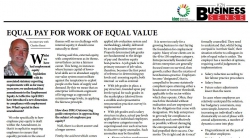Charles Henzi - DRG :- equal pay for work of equal value:2016-04-28 Whilst we have had employment equity legislation with its associated statutory reporting requirements with us for many years now; we understand that amendments to the Employment Equity Act effective April 2015 have introduced a new dimension to compliance with employment law. What's special in these amendments?
We refer specifically to how employee pay equity is dealt within the Amendment, in that it is explicit in requiring employers to ensure that equality prevails in the area of employee remuneration and benefit practices. Employees are now enabled to claim unfair discrimination in such regard. It remains up to the employer to prove to the contrary in the event of such claims. How does this development challenge employers? The irony here is that it shouldn't challenge employers at all, especially where they have been following generally accepted best practice guiding employee reward. What it does do is to reinforce the message that competent human resource and employee remuneration practitioners have been conveying for years, namely, that the equity construct should prevail in all aspects involving the employment of people and especially in their compensation. In this context we need to regard equity as comprising two distinct categories:
our value system must militate against the temptation to exploit people on the basis of supply and demand. By this we mean that an enterprise will remain cognisant of living-wage as opposed to minimum-wage levels, in applying the fairness principle. How does DRG Outsourcing guide enterprises in approaching the subject of employee pay equity? Well, there is a short answer and a longer answer. Firstly, the acid test which comes in two parts:
And the longer answer? This involves the implementation of a logical process, which becomes a component of an enterprise's people and therefore, business practice. Typically, this is how the process unfolds: Firstly, as is the case with any strategic initiative, a guiding philosophy (vision and values) is important. A business strategy must be supported by a human capital strategy which, in turn informs an employee reward strategy. There are financial metrics which inform the viability of our reward strategy, for example, the ratio of employment costs vs. sales turnover, other costs and so on, to inform our decisions. Then:
It is surprising to us to discover how many larger enterprises have not fully either grasped or addressed the implications of employment equity compliance. Often the understanding of employment equity relates only to demographics per job category and required affirmative action initiatives rather than the equal pay for work of equal value principle. Until a statistical analysis of pay distribution by job level and demographics is conducted it's a case of: 'you don't know what you don't know'. When we present our findings in this regard our clients' reaction ranges from surprise, through denial, to concern. It is never too early for a growing business to start laying the foundation for employment equity. Many of our clients are in the 40 to 150 employee category. Entrepreneurially founded and driven enterprises are generally focused more on survival, then growth; rather than the niceties of best-business-practice. Employers become 'designated', that is, compelled to become statutorily compliant upon attaining either a headcount or turnover threshold, applicable to the sector within which they operate. Often, they reach this threshold without realisation and are unprepared for the obligations that come with designation. We help enterprises to get ready for compliance as painlessly and cost-effectively as possible; without damaging the entrepreneurial spirit that had propelled their success. Our motto: 'Do it right and do it once!' Finally, when an employer embarks upon such a process and discovers pay anomalies as you have described, how does it go about resolving them? In advising employers on remedies to pay anomalies and remembering the three previously mentioned categories, we are really talking about risk management. Compliance risk in the context of employment equity, competitive risk in the context of talent and reputational risk in the context in terms the enterprise value system where perceptions of unfairness might impact upon employee motivation. Transparency is an important guiding principle in fixing anomalies where we have either overpaid or underpaid employees; and yes, we often come across overpaid people, relative to best-practice and fairness. In such cases employees must be formally counselled. They need to understand that, whilst being overpaid is 'not their fault', their situation relative to colleagues in jobs of equal value is unfair. The employer has a number of options, requiring careful judgement in implementation:
The discovery and resolution of pay anomalies must be incorporated into policy and procedure with each case carefully documented for the record, to ensure consistency of approach. DRG Outsourcing (Pty) Ltd Tel: +27 (0) 31 - 767 0625 Fax: +27 (0) 31 - 767 3280 david@drg.co.za www.drg.co.za |
Charles Henzi - DRG :- equal pay for work of equal value:
Copyright © 2024 KwaZulu-Natal Top Business
